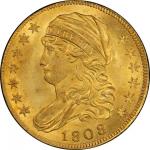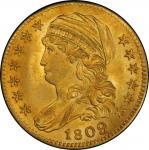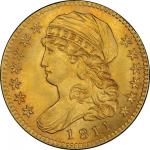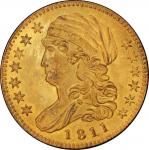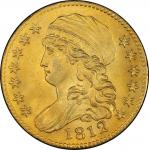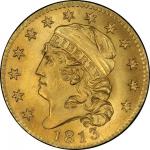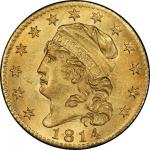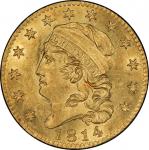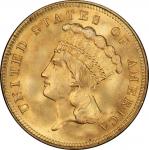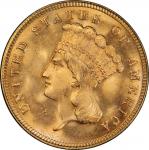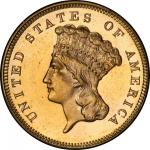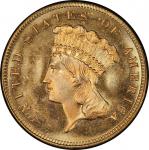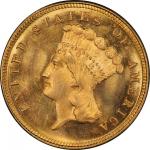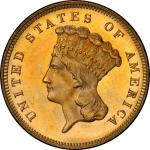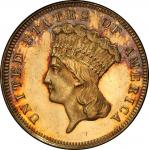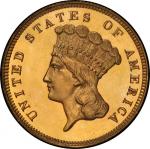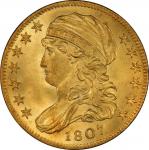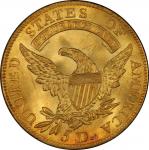“At the Parmelee sale I fell afoul of H.P. Smith. He would often insist on topping me when I would bid, saying ‘you’ve got to pay more for that piece, young fellow.’ We had several arguments during the sale, for I thought he was running prices up on me and let many pieces go on that account. Later I found out he was really buying to complete his own magnificent collection of United States gold.” — William H. Woodin, “The Commercial Element of Numismatics,” The Numismatist, May 1911 An early half eagle of this majestic quality would be the single highlight of nearly any collection and be featured as one of the most important properties in any major numismatic auction. Only in the D. Brent Pogue Collection could this coin be relegated to second in a sequence of spectacular gems, though most serious collectors would agree that its slightly different die state means this is not a precise duplicate. Its color is ideal light yellow gold with hints of palest olive, enriched by deep coppery violet highlights at the base of the reverse that serve as evidence of prime originality. Smaller areas of similar coppery toning are seen at the drapery of Liberty’s bust tip and above her cap. The luster is untrammeled and supremely satiny, and the strike is complete. Some very faint adjustment lines were not fully obliterated at the obverse rim, most notable at the left, though vestiges remain present outside of the denticles around much of the circumference. The fields are as beautiful as the grade promises, with just a shallow abrasion below the eagle’s wing at left and a few sparse lines above the eagle’s head. The devices have been similarly well preserved, receiving just a few trivial lines on Liberty’s cheek. Struck from a somewhat earlier die state than the previous lot, this piece was coined closer to the time these dies clashed and before a substantial portion of the clash marks were lapped out of the fields. The very light outline of the eagle’s wing that is visible in the left obverse field between Liberty’s chin and nose is largely lapped out in a later state, as is the arc from the motto ribbon that crosses atop of 180 in the date. Another portion of the motto ribbon is impressed just above Liberty’s chest. The heavier clash marks near the central obverse, including impressions of the reverse shield, are visible here in much the same state as they are in the later state, suggesting the mint technician’s inability to polish away these recessed and hard-to-reach portions of the die. On the reverse, a short lapping line above the first A of AMERICA is visible here, but not visible on the previous lot, and the talons appear more full, not having yet experienced the light lapping that had occurred by the time the previous coin was struck. Whether specially saved as the first of its kind or accidentally preserved through misadventure or happenstance, this piece has clearly been treated kindly since it was struck. Its visual impression today is about the same as when it first left the Mint. A wealthy child’s eyes may have alighted at its sight as a very special gift, or a banker’s eyes may have narrowed as this piece got lost within the depths of his desk. The story is lost but this artifact remains, and it remains nearly perfect. By 1912, Henry Chapman was an eminence grise among American numismatists, a sober veteran of the hobby and industry who was three decades removed from the 1882 Bushnell sale, his first great success, and not prone to flights of fancy. Chapman began his description of this piece in his catalog of the George H. Earle Jr. sale in typical fashion: “Uncirculated. Sharp, even impression. Mint lustre.” To this somewhat standard catalog entry, a single word was appended, one that rarely appears in the nearly 60-year run of catalogs written by Henry Chapman: “Perfection.” In 1970, Lester Merkin offered this coin as part of what was termed, in Merkin’s usual unadorned style, an “exceptional collection of half eagles.” In a notable contrast, the description waxed eloquent: “Brilliant, frosty, superb Unc., as fine as we have ever seen. One for the perfectionist type collectors.” Harlan Page Smith, the first recorded owner of this coin, was one such perfectionist, a dealer who “always endeavored to improve his own private cabinet” and built a collection that “takes rank with the finest that have ever been sold as regards completeness, rarity, and preservation,” according to the introduction of the May 1906 sale catalog of his collection. Smith, a principal of the New York Coin and Stamp Company, was apparently a bit of an oddball. John W. Adams’ review of his auctions noted that he had both “genuine numismatic talent” and “a rare sense of humor.” His greatest individual cataloging effort was the 1886 sale of the Dr. Edward Maris Collection; his role in the New York Coin and Stamp Company when it offered legendary cabinets like those of Lorin Parmelee and Robert Coulton Davis appears to have been chiefly behind the scenes. Smith retired in January 1902 and died just a few months later. A memorial in the May 1902 issue of The Numismatist reported: “While to a stranger Mr. Harlan P. Smith’s appearance, manners, and methods were repellent, those who knew him well and were acquainted with his kind disposition can only speak of him in terms of the highest praise.” This coin’s whereabouts for the decades following the Earle sale are unknown. A substantial percentage of top grade early half eagles that appeared on the market in this era disappeared into the collections of Virgil Brand or Col. E.H.R. Green. Waldo Newcomer purchased William Woodin’s half eagles in the early 1920s; the entire group went to Col. Green in 1931, via B. Max Mehl. After Stack’s acquired the Col. Green half eagles in 1943, many of the best pieces were sold to Clifford T. Weihman, while another group was sold to King Farouk. Most of the Weihman half eagles became part of the J.K. Lilly Collection, now part of the National Numismatic Collection at the Smithsonian Institution and permanently off the market. Farouk’s coins were indifferently cataloged or sold in large group lots at the 1954 sale of his collection in Cairo, then slowly filtered back into the marketplace by dealers fortunate enough to have attended (or to have been represented at) the sale. Lot 232 in the King Farouk sale included 11 different half eagles of this design type, dated from 1807 to 1811. Simply described as “mostly extremely fine,” the lot was acquired by Texan Robert Schermerhorn for the equivalent of $600. This coin, or others in the Pogue Collection, could have been included. The gaps seen in the provenance of many important coins, usually stretching from World War I into the 1950s or 1960s, are attributable to time spent in one or more of these cabinets which, though now legendary, sometimes left little or no paper trail behind. As indicated in the description of the previous lot, only five pre-1834 U.S. gold coins of any denomination have ever been graded MS-67 or higher by PCGS. Three of them are quarter eagles, two are half eagles; all but one are included in the Pogue Collection. The half eagles, both dated 1807, are offered here in consecutive lots. Reunited two centuries after leaving the Mint by the passionate connoisseurship of D. Brent Pogue, even as they are dispersed these magnificent coins will be forever linked by their provenance and proximity to perfection. PCGS# 507607. NGC ID: 25P9.

